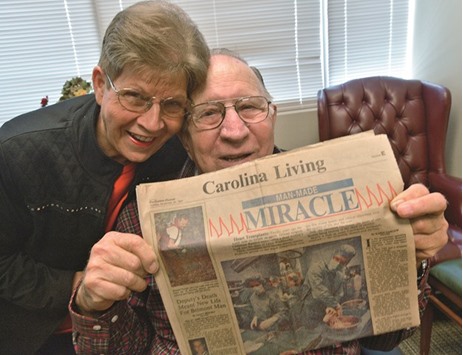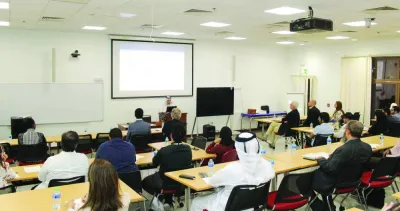Twenty-nine years ago this month, I watched in wonder as surgeons at Carolinas Medical Center performed a heart transplant on a 48-year-old man.
Even today, transplanting a heart is a big deal. But in 1987, the Charlotte programme was less than two years old. As a young health writer, I was excited to don a gown and mask and witness this unusual procedure up close.
When I entered the operating room, the patient, whose name I did not know, was on the table. His chest had been cut open, and his diseased heart had already been removed. The donor heart, from a 35-year-old man in Asheville, had just arrived in a red and white Igloo cooler. I stood nearby as the surgeons connected the healthy new organ to the patient’s blood vessels.
Two weeks later, the Charlotte Observer published my article, Man-Made Miracle. I didn’t think much more about that patient – until a few weeks ago.
That’s when a spokeswoman for Sanger Heart and Vascular Institute at Carolinas HealthCare System asked if I’d like to interview the programme’s longest-living heart transplant recipient.
She told me James Brock, of Cheraw, S.C., has lived with his donor heart for 29 years.
She said his transplant was the subject of an Observer article in 1987. But when I searched the archives, I couldn’t find it under his name.
That’s when it became clear: He was that anonymous patient whose operation I’d watched.
Although I hadn’t known his name, Brock had given permission for me and former Observer photographer Mark Sluder to be in the OR that day. He and his wife, Louise, saved the article, and they brought along their yellowed copy when we finally met earlier this month.
Now 77, Brock is one of the longest-living heart transplant recipients in the world – just four years short of the apparent record holder, John McCafferty of the United Kingdom, who lived 33 years after his transplant.
Thanks to the transplant, Brock and his wife have been married for 58 years. But they’ve known each other since childhood, when their families were neighbours in a rural area about 70 miles southeast of Charlotte.
They’re down-to-earth people – “Just plain, simple country folk,” in Louise Brock’s words – who seem unfazed by the thought of setting a record. Even when James Brock says, “I still can’t believe it,” his voice is so calm you might think he’s talking about the warm weather in November.
Before his transplant, Brock had been on the waiting list for seven months. But he’d been sick much longer. He had his first heart attack when he was 36. “I thought I was a goner,” he said. He returned to work for the CSX railroad in Hamlet, N.C. But heart problems ran in the family – his father died from a heart attack at 47 – and his disease worsened.
In 1985, he had open-heart surgery and went on medical disability. “I couldn’t do anything,” he said.
“He had to sit in his lounge chair,” Louise Brock added.
In early 1987, he was out in his yard when he “felt a spell coming on” and staggered to the neighbour’s house for help. A medical helicopter flew from Charlotte to pick him up. “They said most all of his blood had been pumped out of his heart,” Louise Brock said.
James Brock went home from the hospital, unsure of his future. But the next day, on November 11, the call came about the donor heart, giving him the chance to have 29 more years with his growing family.
The Brocks have three children, and before the transplant, they’d had two grandchildren. Since the transplant, they’ve welcomed three more grandchildren and three great-grandchildren. They’ve also travelled a little, including a trip out West that included Mount Rushmore, the Crazy Horse Memorial and Dodge City. James Brock was also able to return to hunting, his lifelong hobby. In recent weeks, he bagged two deer.
He still takes drugs to fend off rejection of his foreign heart. But dosages have decreased, and he’s down from 16 medicines to six. He visits the Sanger medical team in Charlotte twice a year and gets his blood tested every three months.
For years, Louise Brock washed her husband’s clothes separately. “We had to be careful about germs,” she said. Still, when he gets sick, she said, “We rush him to the doctor.” But it’s been mostly cold viruses, nothing serious.
Dr Sanjeev Gulati, a cardiologist and medical director of Sanger’s heart failure and transplant services, said there are multiple reasons Brock has done so well. Except for his heart, he was relatively healthy before the transplant. The donor heart was healthy and transported quickly to CMC. That allowed surgeons to complete the operation well within the six-hour time limit.
Over 30 years, surgeons at CMC have performed 489 adult heart transplants, with 21 in 2015 and 22 so far this year. CMC has the busiest programme in the Carolinas behind Duke University, which performed 40 adult heart transplants in 2015. One Duke patient has also survived 29 years.
Demand for hearts is greater than available donors, so the number of US transplants remains flat – 2,254 in 2015. Today, even the sickest transplant candidates can potentially wait years for a donor organ because artificial heart pumps can serve as “a bridge to transplant,” Gulati said.
But back in 1987, Brock was lucky to be matched with a donor before it was too late, Gulati said. “He has done a fantastic job of taking care of himself and taking his new heart seriously.…To see someone go from the brink of death to a new life, it’s really incredible.” – The Charlotte Observer (Charlotte, N.C.)/TNS
* Karen Garloch has been the medical writer at The Charlotte Observer since 1987. She was on a team of reporters and editors who were finalists for the 2013 Pulitzer Prize for local reporting for the series Prognosis: Profits which looked at how the state’s major nonprofit hospitals generate large profits and contribute to the high cost of healthcare. She was also nominated for a Pulitzer Prize for her 2001 series, Vernon’s Goodbye, about a Charlotte-area man with advanced cancer who chose to end his life with at-home hospice care.

DOWN MEMORY LANE: James and Louise Brock hold a copy of the Charlotte Observer from November 29, 1987, showing a photo of his heart transplant operation. He remains the longest surviving heart transplant recipient whose operation was performed at Carolinas Medical Center.


